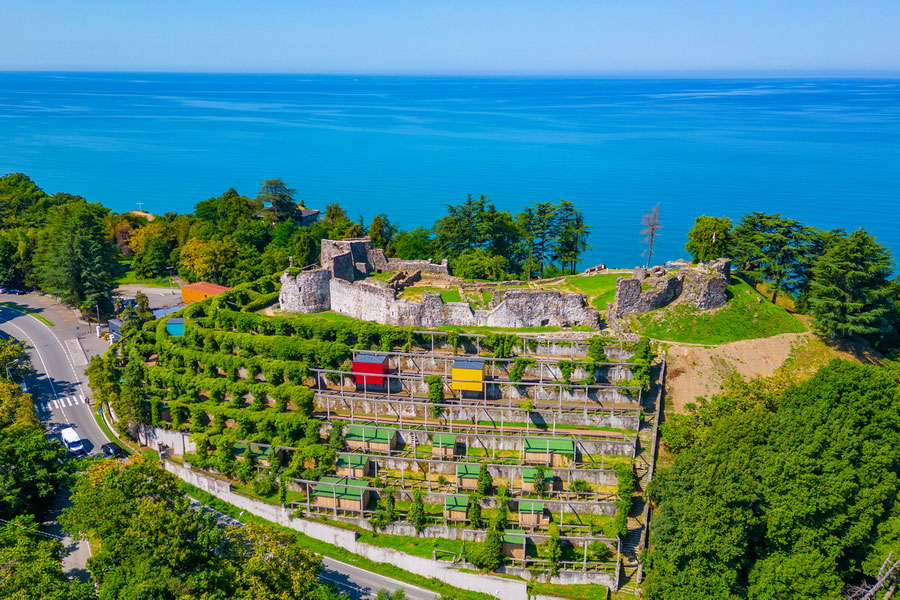
Petra Fortress is one of the rare ancient monuments of Adjara, built in 535. Located 20 km north of Batumi, right above the Black Sea coast, it served a military role for only 16 years before its creators destroyed it. For over a thousand years, the ruins were gradually buried in dense thickets. Today, this popular attraction is often included in tours around Batumi. Its name translates from Greek as "stone" or "rock".
The history of Petra Fortress is closely linked to Justinian I, Emperor of Byzantium from 527-565. In 532, the Iberian War between Byzantium and the Persian Sassanid Empire ended. The term "Iberian" referred not only to the Iberian Peninsula but also to eastern Georgia. Under the peace treaty called "Eternal Peace", the territory of present-day Adjara passed to Byzantium. Emperor Justinian decided to strengthen his empire's eastern borders and ordered the construction of a fortress on the Black Sea coast. Completed in 535, the fortress controlled trade routes along the coast, and its garrison periodically plundered the local population.
Peace between the empires was short-lived. In 541, the Laz revolt began, and the Laz king Gubaza II sought help from the Sassanids. Persian King Khosrow I responded and quickly captured Petra Fortress, fortifying it further. Khosrow aimed to control the entire region and replace Christianity with Zoroastrianism, leading to another revolt in 548. Georgian priests turned to Justinian for help.

The Byzantine emperor responded by sending a large army in 549 to regain the fortress and control of the Laz kingdom. A siege involving 7,000 Byzantine soldiers and 1,000 Laz soldiers ensued, but the commander Dagispheus failed to take decisive action, leading to a retreat. The conflict escalated into what is known today as the Lazic War. In 551, another Byzantine commander, Bess, managed to capture Petra Fortress. To avoid having to defend the strategic site again, it was decided to destroy the fortress. The war continued until 557, and the "Fifty Years Peace" treaty was signed by Justinian and Khosrow in 562. The Laz kingdom returned to Byzantine control but paid annual tribute to the Sassanid Empire, with the Persians agreeing to stop persecuting Christians.
After its destruction, a bishop's cathedral was built on the fortress summit, lasting until the 10th century. The locals referred to the ruins as Kajeti or Kaji. The fortress lay in oblivion for almost eight centuries until the Ottoman Empire began fortifying positions near Batumi in the 18th century. Some sources claim that 25 cannons were placed on top of the fortress during this time. In 1878, the region came under Russian control, and in 1883, a railroad to Batumi was built at the foot of Petra Fortress.
In the first half of the 20th century, during the Soviet era, a large lemonarium was built on the stepped slopes of Petra Fortress. Reinforced concrete structures were erected around the perimeter, glazing was added, and citrus fruits were grown. However, after the collapse of the USSR, the lemonarium gradually fell into disrepair and eventually closed.
Throughout the 20th century, several archaeological excavations were conducted at Petra Fortress, uncovering historical layers, remains of walls, and internal structures. Some findings sparked discussions among scientists, suggesting that there was a settlement on this site even before the Byzantine fortress was built.
Today, Petra Fortress features a complex of stepped terraces on the eastern side, with columns and beams left from the lemonarium, and a citadel with strong walls atop the hill. Inside the citadel, you can find the foundations of a palace, baths, and a basilica. In 2020, the citadel underwent extensive renovations: it was cleared of thick bushes and ivy, a new path to the top was constructed, and a pleasant observation deck was created directly above the sea. If you love antiquities and fascinating stories about historic battles, a tour of Petra Fortress will leave you with vivid impressions.

